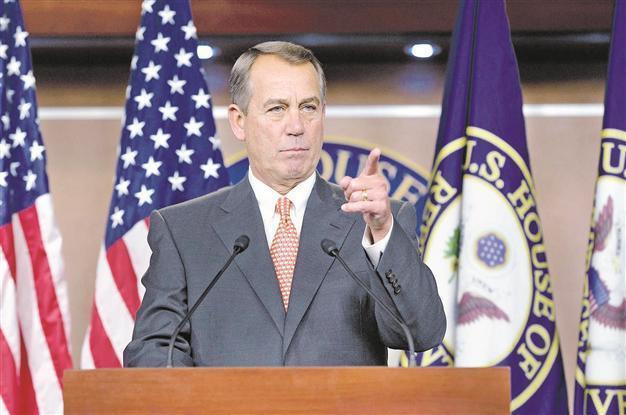US Congress passes new spending bill, averts government shutdown
WASHINGTON - Reuters

Speaker of the House John Boehner speaks during a press conference March 21 at the United States Capitol in Washington, DC. The House of Representatives has passed legislation that will provide funding for the federal government through September and avoids the possibility of a partial federal shutdown. AFP photo
The U.S. House of Representatives eliminated the threat of a government shutdown next week, approving on March 21 a stop-gap funding bill that eases partisan tensions after months of bitter fights over budgets.
In a rare show of cooperation, the Republican-controlled House voted 318-109 to approve legislation that keeps government agencies and programs funded through the end of the fiscal year on Sept. 30.
The debate over how to reduce the deficit will now focus on rival budget plans for fiscal 2014, that begins Oct. 1, put forward by Republicans and Democrats.
While the two parties’ proposals are vastly different, lawmakers were encouraged by the bipartisan collaboration shown in avoiding a damaging government shutdown.
Both parties have been chastened by bruising budget fights like the “fiscal cliff” negotiations that went down to the wire in January, and the failure by Congress and the White House in February to halt automatic spending cuts.
Ryan plan
Current spending authority was to expire on March 27, but Republicans chose not to use the threat of federal agencies running out of money and shutting down as leverage to demand deep spending cuts.
Instead, they want to wage a campaign for deficit reduction centered on proposals from House Budget Committee Chairman Paul Ryan of Wisconsin.
Shortly before approving the spending bill, the House backed a budget blueprint offered by Ryan to eliminate U.S. deficits within 10 years through deep cuts in healthcare and spending on other social safety net programs.
The funding bill for the rest of this fiscal year, which the Democratic-led Senate approved on March 20, keeps in place $85 billion in automatic spending cuts, known as the “sequester.”
But it takes some of the sting out of those cuts by allowing the military and several domestic agencies to shift some money within their reduced budgets to higher priority activities.
The Defense Department, for example, will be able to shift to operations and maintenance some $10 billion that would otherwise be locked in outdated, unwanted budget accounts.
The House vote prompted the Pentagon to announce a two-week delay in any decisions on how much of its 800,000-strong civilian workforce would be put on unpaid leave due to its $46 billion share of the automatic cuts. Officials want to analyze the measure’s impact.
Ball in Obama’s courtThe funding measure will now be sent to President Barack Obama to be signed into law. It gives Congress breathing room for a few months to argue over which party has a more viable budget vision before they face another showdown this summer over raising the federal debt limit.
Ryan’s budget, marked by repeal of President Barack Obama’s health care reforms and deep spending cuts to Medicaid for the poor and other programs, will define Republicans’ positions in the rest of this year’s fiscal battles and in congressional elections in 2014.
It will be matched by a Democratic-focused budget expected to be passed later on March 22 by the Senate, the chamber’s first in four years. That plan, from Senate Budget Committee Chairman Patty Murray, calls for $1 trillion in additional tax revenues, $100 billion in new infrastructure and jobs spending and modest cuts to health care programs.
